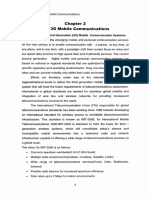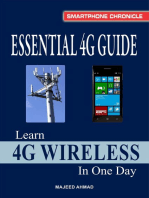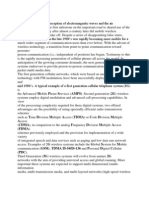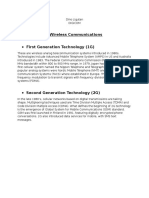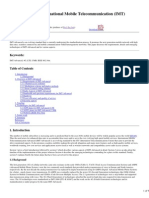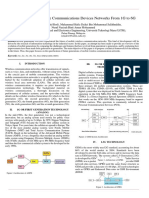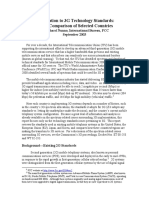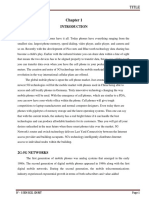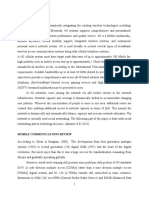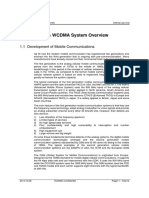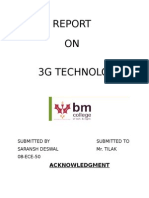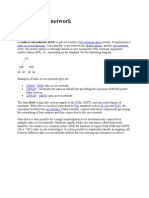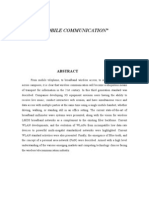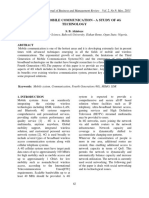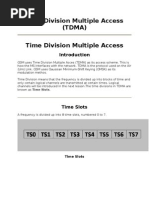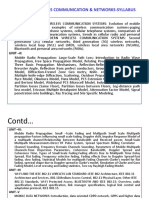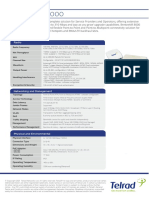2000 The Challenges of Voice Over IP Over Wireless
2000 The Challenges of Voice Over IP Over Wireless
Uploaded by
Alvaro_Armenta_9000Copyright:
Available Formats
2000 The Challenges of Voice Over IP Over Wireless
2000 The Challenges of Voice Over IP Over Wireless
Uploaded by
Alvaro_Armenta_9000Original Title
Copyright
Available Formats
Share this document
Did you find this document useful?
Is this content inappropriate?
Copyright:
Available Formats
2000 The Challenges of Voice Over IP Over Wireless
2000 The Challenges of Voice Over IP Over Wireless
Uploaded by
Alvaro_Armenta_9000Copyright:
Available Formats
The challenges of voice-over-IP-over-wireless
Göran AP Eriksson, Birgitta Olin, Krister Svanbro and Dalibor Turina
Much as second-generation radio access brought mobile telephony capa- high data-rate circuit-switched services,
bilities to the mass market, third-generation radio-access technology will such as real-time video.1
introduce value that extends beyond basic telephony. The widespread
UMTS
growth of the Internet has created a mass market for multimedia and
information services. The challenge of providing this access is twofold: The universal mobile telecommunications
system (UMTS) is being standardized in the
from the market perspective, the challenge is to merge the installed base
Third Generation Partnership Project
of users in cellular and Internet environments; in terms of technology, the (3GPP), which is a joint effort between the
challenge is to find common denominators for cellular solutions on one European Telecommunications Standards
side, and efficient Internet access on the other. To successfully meet Institute (ETSI) and the Association of
these challenges, the third-generation wireless systems must be designed Radio Industries and Broadcasting (ARIB,
to offer a multitude of services, provide considerable flexibility, structured Japan). The basic radio-access technology
QoS handling, and cost-effective access, while ensuring coverage with for UMTS/IMT-2000 in all major areas of
high radio spectrum efficiency. the world is wideband code-division multi-
These design challenges need to be resolved in the future evolution of ple access (WCDMA). The 1999 release of
UMTS and EDGE standards, beginning with the standardization of release the UMTS standard was the first to be im-
2000 in ETSI/3GPP, both regarding the radio-access networks and the plemented in commercial products.
The radio-access part—the universal ter-
common core network. A common denominator for this evolution is the
restrial radio access (UTRA)—includes a
Internet protocol suite, which provides end-to-end solutions for transport frequency-division duplex (FDD) mode and
and network communication, including cellular (radio) access links over a time-division duplex (TDD) mode. The
UMTS/EDGE. FDD mode is based on pure WCDMA,
The authors describe the requirements and current trends in the evolu- whereas the TDD mode includes an addi-
tion of the third-generation wireless systems toward supporting more tional time-division multiple access
generic multimedia applications on a common platform. More especially, (TDMA) component.
they discuss the challenges and solutions involved in designing a packet- The WCDMA system, which uses wide-
switched radio-access network that efficiently supports VoIP service, band direct-sequence technology (DS-
highlighting session control for VoIP service, quality-of-cellular service for CDMA), fully supports the UMTS and
the cellular link, and the challenges of VoIP over wireless. IMT-2000 requirements for 384 kbit/s
wide-area coverage and 2 Mbit/s local cov-
erage. Particularly noteworthy features of
WCDMA are
• support for interfrequency handover,
Introduction which is necessary for high-capacity hier-
archical cell structures (HCS);
Today, the accumulated volume of data traf- • support for capacity-improving technolo-
fic is on the verge of surpassing the accu- gies, such as adaptive antennas and multi-
mulated volume of voice traffic in all pub- user detection.
lic networks. Given the growth in the areas • built-in service flexibility, which pro-
of wireless voice and data, we see that the vides spectrum-efficient access for current
combination of mobile and Internet com- as well as future applications; and
munication constitutes the driving force be- • efficient handling of bursty applications
hind third-generation wireless systems, via an advanced packet-access mode.
which promise to support at least 144 kbit/s WCDMA also provides efficient support for
(384 kbit/s) in all radio environments, and multimedia services; that is, for transferring
up to 2 Mbit/s in low-mobility and indoor multiple services on one connection.1,2
environments.
The standardization of third-generation EDGE
wireless systems is rapidly progressing in all The GSM and TDMA/136 technologies
major regions of the world. These systems— make up the foundation on which the com-
which go under the names of IMT-2000 mon radio access for data services will be of-
(ITU), UMTS, and EDGE (ETSI/3GPP)— fered. The enhanced data rates for GSM and
will extend the services provided by current TDMA/136 evolution (EDGE) concept,
second-generation systems (GSM, PDC, IS- which ETSI and the Universal Wireless
136, and IS-95) with high data-rate capa- Communications Consortium (UWCC)
bilities. The main application for these ser- have adopted as the migration path from
vices will be wireless packet transfer; for in- GSM and TDMA/136, fulfills the require-
stance, for wireless access to the Internet. ments for third-generation wireless systems
However, support will also be provided for according to IMT-2000. EDGE is capable
20 Ericsson Review No. 1, 2000
of offering data services of up to 384 kbit/s Millions of subscribers
and is thus a global complement to the 1000
UMTS radio-access network.
The roadmap for EDGE standardization
has been divided into two phases. Initial em-
800
phasis was placed on enhanced general pack-
et radio service (EGPRS) and enhanced
circuit-switched data (ECSD). According to Mobile
the ETSI time plan, these standards were 600
part of the 1999 release. The second phase
of EDGE standardization, which is target-
ed for release in 2000, will define improve- Internet
ments for multimedia and real-time ser- 400
vices. Other objectives will include the
alignment of services and interfaces with Mobile Internet
UMTS, to allow EDGE and UMTS to share 200
a common core network.
Real-time IP applications over wireless
Second-generation radio-access technology 0
1996 1997 1998 1999 2000 2001 2002 2003 2004
brought mobile telephony to the market. Year
Third-generation radio-access technology
will extend beyond basic telephony: a com- Figure 1
mon, IP-based transport and service plat- The strong growth of mobile communication is expected to continue. Experts predict that
form will offer mobile users a multitude of by the year 2003/2004 there will be close to one billion subscribers of cellular systems
real-time and interactive services.2 worldwide. Similarly, the Internet will continue to grow. By 2004, the number of sub-
scribers to the Internet is also expected to reach one billion. Of this group, more than 350
Typical services with real-time require- million persons will subscribe to the mobile Internet.
ments are voice and video, as well as delay-
sensitive applications, such as traffic-sig-
BOX A, ABBREVIATIONS
3GPP Third-generation Partnership H.323 ITU-T standard for multimedia RRC Radio resource control
Program applications RSVP Resource reservation protocol
AMR Adaptive multirate HCS Hierarchical cell structure RTCP RTP control protocol
API Application program interface IETF Internet Engineering Task Force RTP Real-time transport protocol
ARIB Association of Radio Industries IMT International mobile SAP Service access point
and Broadcasting telecommunication SDP Session description protocol
BER Bit error rate IP Internet protocol SDU Service data unit
CDMA Code-division multiple access IPv4 IP version 4 SGSN Serving GPRS support node
CN Core network IPv6 IP version 6 SIP Session initiation protocol
CRC Cyclic redundancy code IS Intermediate standard SMS Short message service
CRTP Compression for real-time ISDN Integrated services digital network TCP Transmission control protocol
protocol ITU-T International Telecommunication TDD Time-division duplex
DS-CDMA Direct-sequence CDMA Union – Telecommunications TDMA Time-division multiple access
DTMF Dual-tone multiple frequency Standardization Sector TE Terminal equipment
DTX Discontinuous transmission LAN Local area network UDP User datagram protocol
ECSD Enhanced circuit-switched data MS Mobile station (terminal) UE User equipment
EDGE Enhanced data rates for GSM and MT Mobile terminal UED Unequal error detection
TDMA/136 evolution NAS Non-access stratum UEP Unequal error protection
EED Equal error detection PDC Personal digital communication UMTS Universal mobile
EEP Equal error protection PDCP Packet data convergence protocol telecommunications system
EGPRS Enchances GPRS PDP Packet data protocol UTRA UMTS radio access
ETSI European Telecommunications PSTN Public switched telephone network UTRAN UMTS terrestrial radio-access
Standards Institute PT Payload type network
FDD Frequency-division duplex QoS Quality of service UWCC Universal Wireless
FER Frame error rate RAB Radio-access bearer Communications Consortium
GGSN Gateway GPRS support node RAN Radio-access network VoIP Voice over IP
GSM Global system for mobile RLC Radio link control VoIPoW Voice over IP over wireless
communication RNS Radio network server WCDMA Wideband CDMA
GW Gateway ROCCO Robust checksum-based header WWW World Wide Web
GPRS General packet radio service compression
Ericsson Review No. 1, 2000 21
IP service
flexibility
Pure IP
Ideal solution
Spe
efficctrum
ienc
y
icey Circuit-switched voice
Figure 2 Voalit
The voice-over-IP-over-wireless challenge qu
cube.
naling systems, remote sensoring, and sys- which runs counter to the goal of spectrum
tems that provide interactive access to efficiency.
WWW servers. The focus of this article,
however, is on voice service. The voice ser- Network architecture
vice of third-generation wireless systems
must, at the very least, offer the same high overview
level of voice quality, and be as spectrum- To facilitate our ensuing discussion, let us
efficient, as present-day second-generation briefly describe the VoIP service. The basic
realizations. The challenge is to implement components of the voice service are two user
end-to-end service on IP-based transport. terminals with IP-based voice applications
The main advantage of running IP all the and a network that provides end-to-end
way over the air interface is service flexibil- transport between the terminals (Figure 3).
ity. To date, cellular-access networks have The terminals exchange voice samples using
been optimized for voice quality and spec- the real-time transport protocol (RTP),
trum efficiency. The demand for service flex- which has been standardized by the IETF.
ibility adds a new parameter, as illustrated In some situations, terminals can estab-
by Figure 2. Since there are no dependen- lish and maintain communication without
cies between an application and the access the involvement of a third-party entity. At
network, almost anyone can develop new ap- other times, however, the two user end-
plications. But for services like voice over points cannot establish end-to-end commu-
IP over wireless (VoIPoW), the main chal- nication without outside intervention; for
lenge is to achieve quality and spectrum example, when they do not know one an-
efficiency. other’s IP address or do not use the same
To date, all cellular systems that provide voice codec. In these cases, a control plane
voice service have been optimized in a two- framework is used to route incoming traffic
dimensional space whose X-axis and Y-axis and to negotiate terminal capabilities (codec
are voice quality and spectrum efficiency, re- support, multiparty conferencing, and so
spectively. Now, a third dimension is being on)—in traditional telecommunications
added in the form of IP service flexibility. this functionality, which is referred to as call
By bridging the radio interface with IP control, is provided by, say, a GSM mobile
packets, we suffer a lot of protocol overhead, switching center. In the IP world, there are
22 Ericsson Review No. 1, 2000
two main methods of providing call-control session initiation. In contrast to H.323 and
functionality: ITU-T Recommendation GSM/ISDN, SIP/SDP does not provide a
H.323, and the IETF session initiation pro- complete call-control mechanism—an SIP
tocol (SIP). proxy primarily provides routing and ad-
Originally intended for LAN environ- dressing services; device management is not
ments, H.323 is an ITU standard for included. However, the SIP proxy (or VoIP
multimedia applications. Today, however, server) can be enhanced to include func-
the standard is being adopted for broader tionality for offering other services such as
usage. H.323 encompasses a complete transcoding. The session initiation protocol
architecture and a set of protocols, such as is associated with a paradigm in which call
H.225 for call control and H.245 for bear- control is distributed over several entities,
er control. H.323 uses IETF protocols, such and in which the user terminal plays a cen-
as the real-time protocol and the resource tral role in coordinating these entities.
reservation protocol (RSVP). In summary, the two IP-based terminals
Besides end-user terminals, the H.323 ar- exchange voice samples that have been en-
chitecture encompasses gatekeepers, gate- capsulated in RTP over the IP network. The
ways, and multiparty units. In this context, terminals exchange control signaling be-
emphasis is put on the gatekeepers and gate- tween themselves or, with assistance from
ways—which constitute the VoIP server. network entities such as a VoIP server, es-
The gatekeeper part is the controlling unit tablish and maintain communication ses-
that provides call-control functionality; the sions through the network according to ei-
gateway part contains the user plane func- ther the H.323 or SIP paradigm.
tions. H.323 call control is based on Q.931, Both the session initiation protocol and
which is also used in GSM and ISDN. H.323 support end-to-end solutions in
The session initiation protocol, which is which the network solely functions as a bear-
an IETF standard draft, is only one compo- er. In this case we assume that an SIP or
nent in the IETF alternative to the H.323 H.323 network call agent can, if so re-
paradigm for a complete multimedia archi- quested, support the end point (the termi-
tecture. Other necessary protocols and com- nal) with transcoding services.
ponents include the session description pro- The mobile terminal supports cellular ac-
tocol (SDP), the service access point (SAP), cess (UMTS/WCDMA or EDGE) and a
and the real-time control protocol (RTCP). complete VoIP application that is based on
The session initiation and session de- either SIP or H.323. We assume that an
scription protocols (SIP/SDP) do not make adaptive multirate (AMR) codec will be
up an architecture; they were designed for supported by future VoIP clients.
VoIP server Figure 3
Call/session routing Basic VoIP components.
Cellular IP terminal Transcoding Fixed IP terminal
Multiparty conference units
Codec Codec
VoIP ctrl VoIP ctrl
IP IP
Radio Ethernet
SGSN
GGSN Backbone
RNS router
Edge
router
Ericsson Review No. 1, 2000 23
In addition to basic UMTS packet- • The streaming service class applies to real-
switched access, the network contains func- time audio and video-streaming applica-
tions for adapting media, routing calls, and tions. In contrast to the conversational
for authenticating users and services.3 class, this category comprises one-way
transport.
• Typical applications associated with the
Overview of the QoS interactive service class are WWW brows-
concept for the cellular ing and Telnet. The fundamental charac-
link teristic of the interactive class is a request-
response pattern, which makes round-trip
The user’s overall perception of quality of delay an important characteristic. In ad-
service (QoS) is a blanket judgement of the dition, all data transfer must have a low
aggregate contributions from essential com- error rate.
ponents of the communication system. In • The background service class is used for best-
typical communication involving UMTS or effort traffic. Examples of services in this
GSM/EDGE, the transmission phase class are electronic mail (e-mail), short
through the radio-access network (RAN) is message service (SMS) and file transfer.
only one part of the overall end-to-end com- Here, too, all data transfer must have a
munication. Thus, even when the radio- low error rate, although the requirements
access network provides excellent quality of for transfer delay are less stringent.
service, there is no guarantee that the end- The transport for each service class can be
user’s perception of the service or applica- configured in a way that optimizes the effi-
tion is good.4 ciency of the radio network and fulfills the
quality-of-service requirement.
Bearer services within UMTS and Different radio-access bearers (RAB)
GSM/EDGE transport the services through the radio-
Given that frequency spectrum is a sparse access network. Each RAB is associated with
resource in wireless communication sys- a set of attributes that specify the required
tems, we can greatly benefit from applying quality (bit rate, delay and error rate) and
a tailored-to-fit quality-of-service concept supply information on the characteristics of
to the radio-access network. This way, using the traffic flow. This information is essen-
as few radio resources as possible, we can tial for
match each connection with the stipulated • providing a connection with good quali-
quality requirement. ty through the radio-access network; and
To achieve a given network quality of ser- • using spectrum efficiently.
vice, a bearer service—with clearly defined Examples of RAB attributes are service class,
characteristics and functionality—is set up guaranteed bit rate, transfer delay, service
from the source to destination. Each bearer data unit (SDU) loss rate, residual BER, and
service on a specific layer offers its individ- traffic handling priority.
ual characteristics through services that are
provided by subordinate layers. The shaded Service requirements for voice
sections in Figure 4 indicate bearer services
that depend on services provided over the Unequal error detection
air interface. Ordinarily, the bits in a frame from a cellu-
Once again, because frequency spectrum lar voice codec are divided into three class-
is a sparse resource, we readily see the ben- es: 1a, 1b and 2. Bit-error sensitivity varies
efit of being able to classify traffic, in order between these classes—Class 1a includes the
to guarantee system capacity and quality of most sensitive bits; Class 2, the least sensi-
service. By being able to differentiate traf- tive bits.
fic flows in the network, we can define four In a typical second-generation system, the
application-related service classes within bits in Class 1a are covered by a cyclic re-
UMTS and GSM/EDGE: dundancy code (CRC) that checks for errors
• The conversational service class is used for in the frame. Thus we say that the voice
real-time services, such as ordinary tele- frame uses an unequal error detection (UED)
phony voice; for instance, VoIP and video- scheme.
conferencing. The vital characteristics of If information on the different classes of
this class are low transmission delay and bit-error sensitivity cannot be transferred
preserved time relationships, or low-delay from the codec to the radio-access network,
variation, in the traffic flow. or if the bits in the voice frame are not or-
24 Ericsson Review No. 1, 2000
ganized into classes, then the UED scheme
cannot be used. Instead, an equal error de-
TE MT RAN CN CN TE
tection (EED) scheme—a CRC that covers Edge node Gateway
the entire voice frame—is introduced. To toward Iu toward
external
have the quality in these two cases, each networks
must receive the same number of frames End-to-end service
with a bad CRC.
Where circuit-switched traffic is con- UMTS/EDGE
Local bearer bearer service External
cerned, only frames with a bad CRC con- service bearer service
tribute to the frame error rate. But in an IP-
Radio-access CN bearer
based radio network, frames with a bad bearer service service
CRC, frames that are lost due to jitter, and
Radio bearer Iu bearer Backbone
fatal errors in the IP header contribute to the service service bearer service
frame error rate. By fatal errors in the IP
header we mean user datagram protocol Physical Physical
radio bearer bearer
(UDP) checksum errors, errors in the link service service
layer, and header decompression errors.
Unequal error protection
The calculation of the bit error rate (BER)
only includes those errors that occur in bits UMTS/EDGE
not protected by the CRC. The residual er-
rors in bits protected by the CRC must be
Figure 4
as close to zero as possible. If any residual Hierarchical structure of bearer services within UMTS and GSM/EGDE.
bit errors exist in the Class 1a bits, the voice
decoder might produce noticeable artifacts.
If UEP is not available (but UED is), the
lowest FER requirement of Class 1a and the
BER requirement of Class 1b constitute the quality of service that users associate with
channel requirements. present-day circuit-switched realizations
(for instance, GSM circuit-switched voice
End-to-end delay service). To meet this objective, several
The ITU-T recommends the following lim- quality-of-service issues have to be resolved
its on one-way delay: on the core network and radio-access net-
• 0-150 ms—acceptable for most applica- work sides. One objective is to offer voice as
tions. an integral part of emerging public and pri-
• 150-400 ms—acceptable provided the vate conversational multimedia services,
administrator knows what impact the thereby converging the service with archi-
transmission time will have on the trans- tecture solutions developed in the IP do-
mission quality of other user applications. main. A long-term migration solution to
• Greater than 400 ms—unacceptable for this realization implies that equivalent so-
general network planning; however, in lutions to most telephony services must be
some exceptional cases (such as satellite offered over the wireless IP solutions.
hops) this limit will be exceeded. It should be noted that the voice-only ap-
A typical second-generation cellular system plication is considered a special case—as
has a one-way delay of less than 100 ms. part of a multimedia session, voice has more
Thus, to achieve the same high end-to-end complex requirements; that is, in terms of
quality, the one-way delay requirement for BER and delay, different streams in a
the conversational service (terminal-to- multimedia session may have vastly differ-
PSTN) of a third-generation wireless system ent QoS requirements. The Internet world
must also be less than 100 ms. on the fixed side is currently experiencing a
tremendous growth in number of users and
applications. At the same time, the goal of
Optimizations for VoIPoW bridging the wireless air interface intro-
duces additional design challenges. The
Challenges main constraint is the capacity of the radio
The main objective of the VoIPoW concept link, which is a sparse resource that must be
is to port voice service to the new packet- used with care. Consequently, one addi-
data-based platform while retaining the tional requirement for the radio-access net-
Ericsson Review No. 1, 2000 25
work side is to obtain the same or compara- traffic classification. Obtaining the informa-
ble spectrum efficiency for voice services as tion needed to set these attributes is a fun-
from present-day circuit-switched systems. damental problem of transferring IP services
To achieve spectrum efficiency, we can over a radio network. In the IP world, the
benefit from characterizing different pack- application and transport are separate and
et data streams in terms of bandwidth and independent, whereas in the cellular world
delay requirements. Characterizations of the two are usually integrated. Consequent-
this kind are useful when implementing ad- ly, service data must be obtained for setting
mission control algorithms that accommo- up an appropriate radio-access bearer. Apart
date multiple user data streams in available from the RTP stream, the VoIP session also
spectrum. We can also benefit from apply- contains control signaling traffic flows with
ing different methods of minimizing the different characteristics. Moreover, a VoIP
amount of data (such as RTP/UDP/IP head- session might easily be extended to include
er compression and session signaling com- video or a background FTP transfer.
pression) to obtain adequate spectrum effi-
ciency for voice. By minimizing the amount Explicit method
of overhead, we obtain nearly the same level The introduction of an application program
of spectrum efficiency as for the reference interface (API) between the application and
case, in which only voice frames are trans- the radio link enables the explicit ordering
ferred across the radio through a circuit- of proper radio-access bearers. The API can
switched connection.2 be client-based or server-based. By client-
based we mean that the API is between the
Traffic classification in IP networks application part and the radio part in the
When a bearer is requested from the UTRA mobile terminal. By server-based, we mean
or GSM/EDGE radio-access network, the that the API is defined on the fixed side of
service it will bear is described by a number the network between the call agent (an
of parameters (radio-access bearer attribut- H.323 server, for example) and the cellular
es), such as guaranteed bit rate, residual radio network.
BER, packet loss rate, and delay. Therefore,
to request an optimum VoIP bearer from the Implicit method
radio-access network, the requesting entity A more transparent method of obtaining ser-
must know the attribute settings of the vice data is to develop a flow-classification
radio-access bearer. The procedure for de- algorithm that examines the headers of
termining and assigning values to the at- packets and extracts information on flows
tributes of the radio-access bearer is called for identifying and characterizing them.
Figure 5 shows the principle that applies in
real-time situations. The RTP header con-
tains a payload-type (PT) field that identi-
fies the source codec. However, the PT can
Figure 5 also be dynamic, in which case information
Flow classification tree. on the codec is unavailable. In this case, the
algorithm measures parameters, such as
packet size and inter-arrival time. From
these parameters, it might be possible to
identify the codec or to give direct input to
TCP the radio-bearer parameters. How much in-
UDP formation the algorithm can provide de-
pends on the depth of the tree. For instance,
RTP
the algorithm could be extended to capture
Non-
specific signaling messages. Obviously, the
RTP complexity of the tree and the time it takes
to go through it are limiting factors.
Measurement Header compression for real-time IP
codec
phase The large headers of the protocols used when
voice data is sent over the Internet consti-
tute a major problem with voice over IP over
wireless. An IP packet with voice data will
have an IP header (20 octets), a UDP head-
26 Ericsson Review No. 1, 2000
VoIP session
Voice RTCP Basic SIP DTMF Charg. Suppl. service
samples
RTP UDP UDP RTP TCP UDP
UDP UDP RSVP
IP IP IP IP IP IP IP
PDP_RTP
PDP_Sig
PDP_BE
PDCP_BE PDCP_Voice PDCP_Sig PDCP
RAB0
RLC_BE RLC_Voice RLC_Sig RLC
MAC
Figure 6
PHY Conceivable realization of a VoIPoW user
session.
er (8 octets), and an RTP header (12 octets) at all, and fields with only minor changes
for a total of 40 octets. In IPv6, the IP head- can be updated with only a few bits. How-
er is 40 octets, which raises the total to 60 ever, when frames are lost or damaged over
octets. The size of the voice data depends on the channel, as can occur on cellular links,
the codec and can be as small as 15 to 30 the context on the downstream side cannot
octets. These numbers make a strong argu- be updated properly and the decompression
ment for terminating the IP protocols be- of subsequent headers produces incorrect
fore the air interface: the IP/UDP/RTP headers. Thus, the header-compression
headers consume too much bandwidth and schemes must have mechanisms for in-
make inefficient use of valuable radio spec- stalling context, for detecting when the con-
trum. However, it is possible to overcome text is out of date, and for repairing the
this problem with header compression. downstream context when it is incorrect.
No header information in a voice packet Several header-compression algorithms
can be discarded, but because there is a high are being standardized by the IETF. For
degree of redundancy in the fields of head- VoIP, the compressed RTP (CRTP) can
ers of consecutive packets that belong to the compress 40-octet IPv4/UDP/RTP headers
same packet stream, this information can be to a minimum of 2 octets.5 To repair con-
compressed by means of header-compression text, the CRTP relies on an upstream link
algorithms. These algorithms maintain a over which the decompressor sends requests
context, which is essentially the uncom- for updating the headers. All packets re-
pressed version of the last transmitted head- ceived by the decompressor are lost while
er at each end of the channel over which the context is out of date, since the headers
header compression occurs. The compressed cannot be decompressed. The round-trip
headers solely carry changes to the context. time over the link will thus limit the effi-
Static header fields need not be transmitted ciency of the context-repair mechanism.
Ericsson Review No. 1, 2000 27
Compressor Decompressor bustness and compression performance
against channel quality for VoIPoW service
Original header Payload when tested with different types of com-
pression schemes and channel types.
In addition to the ROCCO header check-
CRC sum, a code that is included in the com-
pressed header provides the decompressor
with information on how the header fields
have changed; for example, due to loss over
the cellular link. For the ROCCO VoIP pro-
Try again with modfied
file, this code contains enough information
Reconstruct reconstruction on previous headers to enable local repair of
header the context after several (up to 26) consecu-
tive packets have been lost between the com-
Reconstruction No pressor and the decompressor. The profile
correct?
with the maximum compression ratio has a
Yes Give up minimal header size of one octet. The abil-
ity to repair context locally virtually elimi-
Forward packet Request update nates the negative effect of long round-trip
times on header-compression performance.
Figure 7 Radio-access bearers for VoIP
ROCCO—the robust checksum-based header-compression scheme.
The main challenge in designing radio-
access bearers is to find suitable implemen-
tation points (Figure 2). These are domi-
nated either by requirements for IP service
flexibility or by requirements for spectrum
efficiency. Different points satisfy these re-
Link-level simulations show that the pack- quirements to different degrees. For exam-
et-loss rate for CRTP is about four times ple, the amount of protocol overhead (that
greater than for an ideal scheme in a VoIP- is, the IP header) cannot be minimized if IP
over-WCDMA scenario. To be viable, the service flexibility must be combined with
header-compression scheme for VoIP-over- end-to-end encryption. On the contrary, if
wireless cannot be less efficient but must be we solely want to implement voice service,
less fragile than CRTP. we can use a radio-access bearer to obtain a
Ericsson’s response to these requirements solution, which in terms of spectrum effi-
is a header-compression scheme that pro- ciency, is comparable to that of present-day
vides a high degree of compression and is solutions.
suitably robust for use in cellular applica- In summary, the radio-access network of
tions (Figure 7). The robust checksum- a third-generation all-IP wireless system
based header-compression (ROCCO) should support VoIP applications by means
scheme is heavily geared toward local con- of a
text repair.6 A checksum that covers the • voice-optimized radio-access bearer
original (uncompressed) header is included whose service characteristics and spec-
in the compressed header to introduce a re- trum efficiency match that of circuit-
liable way of detecting when switched voice—for instance, by means of
• the context is out of date; and the AMR codec.4 All IP-related overhead
• local attempts to repair the context have is terminated before bridging the wireless
succeeded. air interface. A trusted proxy is needed on
Moreover, to achieve really good compres- the network side and no IP service flexi-
sion and robust performance without losing bility is offered to the mobile user.
generality, Ericsson has also introduced a • voice-optimized radio-access bearer
compression profiles concept. To achieve whose service characteristics and spec-
optimum performance, different compres- trum efficiency are similar to that of
sion profiles handle different RTP streams circuit-switched voice. Voice frames are
and channel conditions. Various profiles are transferred across the air interface togeth-
being developed for voice and video streams. er with the compressed IP overhead—for
A general, all-purpose profile might also be example, using header-compression algo-
developed. Figures 8 and 9 compare ro- rithms.1 Additional optimization might
28 Ericsson Review No. 1, 2000
be obtained from unequal error protection Packet loss rate [%]
(UEP) or from unequal error detection 10
(UED) that matches the voice codec in CRTP-WCDMA
use. This solution allows for migration to 9
an all-IP wireless system that efficiently
supports telephony service. 8
• generic radio-access bearer for real-time
user-to-user IP connectivity; that is, by 7
supporting data streams that belong to CRTP-EDGE
6
the multimedia session and using
RTP/UDP/IP. This solution provides
5
total IP flexibility to new IP multimedia
applications and in cases where security 4 ROCCO-WCDMA, 2oct
mechanisms (IPsec) do not allow for head- ROCCO-WCDMA, 1oct
er compression. 3 ROCCO-EDGE, 2oct
Overview of VoIPoW realizations in ROCCO-EDGE, 1oct
2
UTRA and GSM/EDGE networks
To provide efficient and cost-effective solu- 1
tions for deploying end-to-end IP-based
multimedia services that satisfy the elevat- 0
-4 -3 -2
ed standard of QoS for UMTS (the radio 10 10 10
Bit error rate
part), the UTRA network must select the
radio-access bearers that best suit the car-
Figure 8
ried service. By optimizing how the radio Global overview of data streams that relate to a VoIPoW call.
resource is provided, we can also maximize
system capacity. Figure 8 depicts a global
overview of the data streams that relate to a
VoIPoW call.
Data streams with similar characteristics
and approximately the same QoS require-
ments can be logically grouped and mapped
onto the same radio bearer. Within a
VoIPoW session, a few relevant classes have
been identified: Figure 9
Simulated results of CRTP header compression.
• RTP voice stream (RAB2)—the transfer
of voice data requires the lowest possible Average header size (octets/packet)
delay, no jitter, and BER of 10-4 (less if a 4
robust header-compression mechanism
cannot be used). Since low delay require-
ments do not permit retransmission, the
3.5
preferred choice for the voice stream is a
transparent RLC service—with guaran- CRTP-WCDMA
teed peak bit rate—that does not intro- CRTP-EDGE
3
duce any additional protocol overhead.
• Application signaling (RAB1)—RTCP,
H.323 or SIP, RSVP. This category has
less stringent delay requirements but de- 2.5
mands better data integrity than voice. ROCCO-WCDMA, 2oct
The requirement for data integrity can be
met by means of retransmission at the 2 ROCCO-EDGE, 2oct
RLC level. In some cases, the quality re-
quested by this kind of signaling cannot
be matched by a pure best-effort radio- 1.5
access bearer. Therefore a guaranteed ROCCO-WCDMA, 1oct
minimum bit rate should be considered
ROCCO-EDGE, 1oct
within the acknowledged RLC service 1
mode. To avoid over-providing orthogo- -4
10 10
-3
10
-2
nal codes—provided more bandwidth is Bit error rate
Ericsson Review No. 1, 2000 29
System quality, 1.Circuit-switched voice service with equal
the 95th percentile of FER error protection. This case is included as
0.017 a benchmark. The capacity of this solu-
CRTP HC tion is used to normalize the other results.
0.016 Circuit- In all likelihood, the circuit-switched
switched voice service in WCDMA will use un-
equal error protection. Thus, in terms of
0.015
capacity, the studied results are slightly
pessimistic. Nonetheless, the results of
0.014 this solution suffice for comparison with
Full RTP/UDP/IP header ROCCO HC voice-over-IP cases, to investigate the ef-
0.013
fects of the upper protocol layers on sys-
tem capacity. For the air interface, this so-
lution is the equivalent of one that ter-
0.012
minates IP-related overhead in the net-
work.
0.011 2.IP-based voice service with full
RTP/UDP/IP header. This IP service
0.010 sends the complete RTP/UDP/IP header
over the air interface.
3.IP-based voice service with CRTP
0.009
0.3 0.4 0.5 0.6 0.7 0.8 0.9 1 1.1
header compression. The same IP-based
Relative load service as in no. 2, above, apart from the
introduction of the CRTP header-
Figure 10 compression scheme.
Simulation results of UMTS voice services. 4.IP-based voice service with ROCCO
header compression. The same IP-based
service as in no. 2, above, apart from the
introduction of the ROCCO header-
compression scheme.
The capacity figures for each of the differ-
required for occasional bursty signaling ent cases were derived in a WCDMA system
during voice—the use of common or simulator. The simulator models an area
shared channels should be considered. with hexagonal cells covered by three sector
• Radio resource control (RRC) and non- sites. During the simulation, mobile calls
access stratum (NAS) signaling were initiated according to a Poisson process
(RAB0)—UTRA network control signal- and distributed uniformly over the area. The
ing is used to exchange messages between call duration figures were distributed expo-
the UMTS network and the user equip- nentially, with a mean holding time of 120
ment. Rapid and reliable delivery of mes- seconds. During calls, the mobile terminal
sages can have a major impact on the per- generated or received voice frames from a
formance of the entire system. Therefore, model of the AMR 12.2 codec operating in
the transmission of UTRA network mes- discontinuous transmission (DTX) mode.
sages must be guaranteed, reliable, and Before and after calls, some IP-related sig-
have low delay and top priority. naling (H.323 and RSVP) was transferred
Note: not all the data streams of the over the radio link. The model did not in-
VoIPoW session depicted in Figure 8 are ac- clude RTCP and RSVP signaling during
tive at the same time. In fact, most of them calls.
can be decoupled. The objective was to estimate capacity at
a constant level of quality. However, because
Evaluating the capacity of VoIPoW it is difficult to measure perceived voice
System simulations have been made to de- quality in a simulator, the quality measure
termine how the introduction of IP service of a single connection was based on frame
flexibility in the WCDMA-based UMTS error rate (FER). Listening tests indicate
system affects capacity. The focus of the sim- that there is a correlation between the per-
ulations was on the radio link, which is con- ceived voice quality of a connection and
sidered to be the bottleneck of the system. FER.
Four different cases, each representing a dif- The measure of system quality—to de-
ferent technical solution, were studied: termine system capacity—was not based on
30 Ericsson Review No. 1, 2000
an average connection, but on the number suring high radio-spectrum efficiency. The
of connections with acceptable quality. In UMTS and GSM/EDGE radio-network ar-
this investigation, adequate system quality chitecture and quality-of-service concept are
was defined as less than 1% FER for at least designed to support the needs of present-day
95% of all connections. For a given level of and future applications. The concept of bear-
system quality, capacity was defined as the er services at different network levels makes
maximum load for which this level can be up the basis for providing end-to-end
achieved. Capacity was measured relative to quality-of-service—transport through the
the reference case (1) whose capacity was 1.0. radio-access network is provided via radio-
The simulation results (Figure 10) show access bearers.
that for low loads, The main objective of the VoIPoW con-
• the interference level of the system is mod- cept is to port voice service to the new pack-
erate; and et-data-based platform while maintaining
• the power control is able to set the indi- the perceived quality-of-service and spec-
vidual power levels in such a way that trum efficiency associated with present-day
95% or more of the users have connections circuit-switched wireless systems. Given
with the desired level of quality this objective, we see that we cannot choose
(FER† 1%). a single point of implementation. Instead,
When the load was increased, the interfer- the main challenge is to find suitable points
ence level also increased, and at some point of implementation that satisfy the voice-
the system became overloaded. When the service requirements for IP service flexibil-
system becomes overloaded, interference is ity or spectrum efficiency. By introducing
excessive and too many connections are bad; traffic classification and header compression
that is we reach the capacity limit of the sys- we can offer a spectrum-efficient VoIPoW
tem. When the complete RTP/UDP/IP service with high voice quality and IP ser-
header was sent over the air interface, ca- vice flexibility.
pacity dropped to approximately 50% that The aim of designing the third-
of the circuit-switched reference case. When generation all-IP wireless network is to sep-
CRTP header compression was applied (Fig- arate core and radio-access network compo-
ure 10), capacity dropped to approximately nents, thereby allowing a common packet-
80%; when ROCCO header compression switched core network (based on GPRS) to
was used, capacity dropped only 10% (to ap- be used for UMTS and GSM/EDGE radio-
proximately 90%). access networks.
The impact on capacity of RSVP and A key objective of third-generation all-IP
RTCP signaling, which was not included in networks is to provide a capable service plat-
the simulations, depends on the extent to form for IP-based applications. The solu-
which it can be reduced and compressed. If tions we have described for audio streams
the signaling is not reduced, the loss in ca- and associated control protocols will ad-
pacity due to IP-related signaling will equal vance the UMTS network another step to- REFERENCES
that caused by compressed headers. ward becoming a full-fledged service plat-
form that can support demanding services,
1 Nilsson, M.: Third Generation Radio Access
such as IP-based conversational multi-
Conclusion media.
Standards. Ericsson Review Vol. 76
(1999):3, pp. 110-121.
The widespread growth of the Internet has 2 Nilsson, T.: Toward third-generation mobile
created a mass market for multimedia and multimedia communication. Ericsson
Review Vol. 76 (1999):3, pp. 122-131.
information services. The challenge of pro-
3 Dahlin, S. and Örnulf, E.: Network Evolution
viding these services via third-generation the Ericsson Way. Ericsson Review 76
wireless systems is twofold: from the mar- (1999):4, pp.174-181.
ket perspective, the challenge is to merge 4 Madfors, M.: Radio Access Network and
the installed base of users in cellular and In- Quality of Service in Future Wireless Net-
works. Future Telecom Forum 99, Beijing,
ternet environments; and in terms of tech- China, December 1999.
nology, the challenge is to find common de- 5 Casner, S. and Jacobson, V.: Compressing
nominators for cellular solutions and effi- IP/UDP/RTP Headers for Low-Speed Serial
cient Internet access. To succeed in meeting Links, RFC 2508, February 1999.
6 Jonsson, L.-E., Degermark, M., Hannu, H.
these challenges, third-generation wireless
and Svanbro, K.: Robust checksum-based
systems must be designed to provide a mul- header compression (ROCCO). Internet-
titude of services, offering considerable flex- Draft (work in progress) draft-jonsson-
ibility and cost-effective access with struc- robust-hc-03.txt. Ericsson Research, Janu-
tured quality-of-service handling and en- ary 2000.
Ericsson Review No. 1, 2000 31
You might also like
- 3G ArchitectureDocument11 pages3G ArchitecturelqcckagopzkluvrayxNo ratings yet
- Concise Guide to OTN optical transport networksFrom EverandConcise Guide to OTN optical transport networksRating: 4 out of 5 stars4/5 (2)
- Essential 4G Guide: Learn 4G Wireless In One DayFrom EverandEssential 4G Guide: Learn 4G Wireless In One DayRating: 4.5 out of 5 stars4.5/5 (12)
- Marconi S Innovative Perception of Electromagnetic Waves and The AirDocument11 pagesMarconi S Innovative Perception of Electromagnetic Waves and The AirVishal IyerNo ratings yet
- Seminar Report Submitted in Partial Fulfilment of The Requirements For The Award of The Degree ofDocument37 pagesSeminar Report Submitted in Partial Fulfilment of The Requirements For The Award of The Degree ofderviii100% (1)
- Third Generation (3G) BackgroundDocument24 pagesThird Generation (3G) BackgroundSihirli HazineNo ratings yet
- A New Approach To Minimise Network Blocking in 4g For Better AccessibilityDocument5 pagesA New Approach To Minimise Network Blocking in 4g For Better AccessibilityericNo ratings yet
- Wireless Communication TechnologiesDocument10 pagesWireless Communication TechnologiesDino LigutanNo ratings yet
- mhdC8Vuv5Ntvq8MUqJCZI9Jo PDFDocument34 pagesmhdC8Vuv5Ntvq8MUqJCZI9Jo PDFAhmed58seribegawanNo ratings yet
- RF Transceiver Architectures For W-CDMADocument10 pagesRF Transceiver Architectures For W-CDMABình PhạmNo ratings yet
- 4G Wireless and International Mobile Telecommunication (IMT) AdvancedDocument9 pages4G Wireless and International Mobile Telecommunication (IMT) AdvancedftbjadeNo ratings yet
- The Promise of 3GDocument18 pagesThe Promise of 3GCzarina NabilahNo ratings yet
- Unit 1 AMCS - Week 1 LectureDocument13 pagesUnit 1 AMCS - Week 1 LectureMANASA P (RA2011004010071)No ratings yet
- Modern Wireless Communication Systems: 2.1 1G: First Generation NetworksDocument12 pagesModern Wireless Communication Systems: 2.1 1G: First Generation NetworksImran SikderNo ratings yet
- The Evolution of Mobile Communications Devices Networks From 1G To 6G-Edited - 1Document5 pagesThe Evolution of Mobile Communications Devices Networks From 1G To 6G-Edited - 1Ahmad Zahin Mohd RosliNo ratings yet
- 4G and Its EvolutionDocument11 pages4G and Its EvolutionVamsee KrishnaNo ratings yet
- EDGE: Enhanced Data Rates For GSM EvolutionDocument38 pagesEDGE: Enhanced Data Rates For GSM EvolutionShebin.A.Khalam100% (1)
- Analysis of Simulation Parameter of WCDMA For Root Raised Cosine FilterDocument17 pagesAnalysis of Simulation Parameter of WCDMA For Root Raised Cosine FilteravnishNo ratings yet
- 3G Cellular Systems PDocument4 pages3G Cellular Systems Pthamilmani12No ratings yet
- Mobile Communications: Lecturer: Michael O'GradyDocument54 pagesMobile Communications: Lecturer: Michael O'GradyNayansi GuptaNo ratings yet
- Migration To 3G Technology Standards: A Comparison of Selected CountriesDocument14 pagesMigration To 3G Technology Standards: A Comparison of Selected CountriesBuchi ReddyNo ratings yet
- 3g Mobile Communication TechnologyDocument12 pages3g Mobile Communication TechnologykhushigourNo ratings yet
- 4g EvolutionDocument20 pages4g EvolutionRabeb BANo ratings yet
- 4G Technology: Communication Skills and Soft Skills LabDocument5 pages4G Technology: Communication Skills and Soft Skills LabFermi NivedithaNo ratings yet
- Chapter 3Document33 pagesChapter 3fracasstoneNo ratings yet
- Survey On Umts and Lte Performance On The Basis of Data RatesDocument3 pagesSurvey On Umts and Lte Performance On The Basis of Data RatesRobelNo ratings yet
- Millimeter Wave Mobile Communications for 5GDocument15 pagesMillimeter Wave Mobile Communications for 5Gabdulbasit.rana89No ratings yet
- WCDMA Air InterfaceDocument54 pagesWCDMA Air InterfaceRookie2No ratings yet
- Title: Iv - I Sem Ece, CmritDocument24 pagesTitle: Iv - I Sem Ece, CmritKanna vaibhav GuptaNo ratings yet
- 4g TechnologyDocument7 pages4g TechnologyGaurav PatelNo ratings yet
- Bimbo SeminarDocument19 pagesBimbo Seminargolden abidemNo ratings yet
- Presented by Rishabh ShahDocument22 pagesPresented by Rishabh ShahSurya6556No ratings yet
- Huawei WCDMA System Overview CourseDocument245 pagesHuawei WCDMA System Overview Coursejkpllan3No ratings yet
- Difference in 1G, 2G, 3G, 4GDocument5 pagesDifference in 1G, 2G, 3G, 4GAamir MalikNo ratings yet
- Mobile Technology: Evolution From 1G To 4G: CommunicationsDocument5 pagesMobile Technology: Evolution From 1G To 4G: CommunicationsHammna AshrafNo ratings yet
- 4G-Beyond 3G and Wireless Networks: Indira Gandhi National Open University (IGNOU), Delh, IndiaDocument8 pages4G-Beyond 3G and Wireless Networks: Indira Gandhi National Open University (IGNOU), Delh, IndiaChara SukaNo ratings yet
- EDGE ReportDocument22 pagesEDGE ReportSowmya SowmyaNo ratings yet
- 4G Technology - : Magic CommunicationDocument10 pages4G Technology - : Magic CommunicationBhaskar Rao OndruNo ratings yet
- What Is IMT-2000 ?: Wireless GenerationsDocument7 pagesWhat Is IMT-2000 ?: Wireless Generationsneeraj kumar singhNo ratings yet
- 2 Ch1broadbandDocument34 pages2 Ch1broadbandAbdullah HabibNo ratings yet
- Performance Study of 5G Multicarrier Waveforms: A.elabbassi@fste - Umi.ac - MaDocument6 pagesPerformance Study of 5G Multicarrier Waveforms: A.elabbassi@fste - Umi.ac - MaSimon TarboucheNo ratings yet
- Chapter 2Document12 pagesChapter 2Badri Vishal PandeyNo ratings yet
- 3G Tutorial UMTS OverviewDocument5 pages3G Tutorial UMTS Overviewmanisha.kalita9253100% (3)
- EEE 311 Report_Generations of Mobile Networks_2020153Document6 pagesEEE 311 Report_Generations of Mobile Networks_2020153SAMIN MUIZZ 25No ratings yet
- Fourth Generation Wireless Systems 4G: AbstractDocument10 pagesFourth Generation Wireless Systems 4G: AbstractHarsha CharanreddyNo ratings yet
- This Is What We NeedDocument3 pagesThis Is What We NeedKrishna chhetriNo ratings yet
- SVC Dinesh. MDocument10 pagesSVC Dinesh. MJanani SubramanianNo ratings yet
- C Refers To The Fourth Generation of Cellular Wireless Standards. It Is A Successor ToDocument10 pagesC Refers To The Fourth Generation of Cellular Wireless Standards. It Is A Successor ToPrabahar RamasamyNo ratings yet
- IEEEconference EzhilDocument5 pagesIEEEconference Ezhilyounas125No ratings yet
- Report On 3G TechnologyDocument11 pagesReport On 3G TechnologySaransh DeswalNo ratings yet
- Telecommunication Radio Access Technology Mobile Phone Core NetworkDocument4 pagesTelecommunication Radio Access Technology Mobile Phone Core NetworkRajjak ShahNo ratings yet
- 4g Wireless System FullDocument6 pages4g Wireless System Fullkalbande86No ratings yet
- Mobile CommDocument11 pagesMobile CommReena JosephNo ratings yet
- Wireless Mobile Communication - A Study of 4G Technology: S. B. AkintoyeDocument11 pagesWireless Mobile Communication - A Study of 4G Technology: S. B. AkintoyeSorin DobreNo ratings yet
- 4G Full Paper GistDocument9 pages4G Full Paper GistSrini VasuluNo ratings yet
- 5th Sem CN Lab Manual 2021-22Document69 pages5th Sem CN Lab Manual 2021-22Divya-Kalash -1BY19IS055100% (1)
- TDMA - Time Division Multiple AccessDocument13 pagesTDMA - Time Division Multiple AccessBejetaNo ratings yet
- Channel Access MethodDocument6 pagesChannel Access MethodMohamed EmraanullahNo ratings yet
- WCN Unit IDocument71 pagesWCN Unit IvmspraneethNo ratings yet
- Lecture Notes Wireless CommunicationDocument87 pagesLecture Notes Wireless Communicationmohit virmaniNo ratings yet
- Project ReportDocument6 pagesProject ReportSalmaAliNo ratings yet
- Mobile COMPUTINGDocument169 pagesMobile COMPUTINGNPMYS23No ratings yet
- Final - Sum SmallDocument72 pagesFinal - Sum Smalledna sisayNo ratings yet
- Application Areas and MAIO Planning RecommendationsDocument2 pagesApplication Areas and MAIO Planning RecommendationspoteNo ratings yet
- TelecomDocument108 pagesTelecomDhuftan Worraa RorrooNo ratings yet
- A Comparison Study of The Uplink Performance of W-CDMA and OFDM For Mobile Multimedia Communications Via LEO SatellitesDocument9 pagesA Comparison Study of The Uplink Performance of W-CDMA and OFDM For Mobile Multimedia Communications Via LEO Satelliteskaramella13No ratings yet
- Questions Bank With Solutions (Ad Hoc Network and Wireless NW)Document15 pagesQuestions Bank With Solutions (Ad Hoc Network and Wireless NW)GauravNo ratings yet
- BreezeAIR8000 5 17Document1 pageBreezeAIR8000 5 17Felipe PayacanNo ratings yet
- Chapter Two: Modern Wireless Communication SystemsDocument36 pagesChapter Two: Modern Wireless Communication SystemsRoba TayeNo ratings yet
- Chapter-1: 1.2 Operation of VSAT SystemsDocument23 pagesChapter-1: 1.2 Operation of VSAT SystemsMallinath SkNo ratings yet
- IoT WSN Module 5 2018 by Prof SV 1 PDFDocument43 pagesIoT WSN Module 5 2018 by Prof SV 1 PDFmanju0071No ratings yet
- Multiplexing and Multiple AccessDocument63 pagesMultiplexing and Multiple AccessamsousefulNo ratings yet
- Unit 3 Question Bank-1Document10 pagesUnit 3 Question Bank-1Nani tomNo ratings yet
- Multiple Choice Questions - Wireless CommunicationDocument3 pagesMultiple Choice Questions - Wireless CommunicationRavi RanjanNo ratings yet
- SRM University Department of Information Technology Lesson PlanDocument4 pagesSRM University Department of Information Technology Lesson PlanRehanNo ratings yet
- LCSF - Wireless Communications Laboratory: Teaching Unit: Academic Year: Coordinating UnitDocument12 pagesLCSF - Wireless Communications Laboratory: Teaching Unit: Academic Year: Coordinating UnitIrfanKhanNo ratings yet
- Wideband Power Sensor Models 5012D, 5016D, 5017D, 5018D and 5019DDocument46 pagesWideband Power Sensor Models 5012D, 5016D, 5017D, 5018D and 5019DGodyNo ratings yet
- Interference Rejection Combining System PerformanceDocument73 pagesInterference Rejection Combining System PerformanceumeraftabranaNo ratings yet
- Mobile Phone Notes PDFDocument21 pagesMobile Phone Notes PDFMallikarjuna SettyNo ratings yet
- Introduction To Cellular Networks: 1G/2G/3GDocument43 pagesIntroduction To Cellular Networks: 1G/2G/3GDarko PazaninNo ratings yet
- Traffic and Control Channels in GSMDocument39 pagesTraffic and Control Channels in GSMMd. Golam Sarwar JoyNo ratings yet
- Multiple Access Protocol: Presented By, J.Merlin Florrence I M.SCDocument35 pagesMultiple Access Protocol: Presented By, J.Merlin Florrence I M.SCsrivatsa.a.malali srivatsa.a.malaliNo ratings yet
- EC6004 Satellite CommunicationDocument14 pagesEC6004 Satellite CommunicationSumeshNo ratings yet
- Medium Access Control PDFDocument47 pagesMedium Access Control PDFTadesse DestawNo ratings yet
